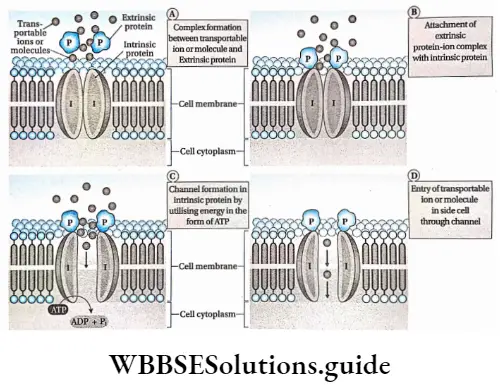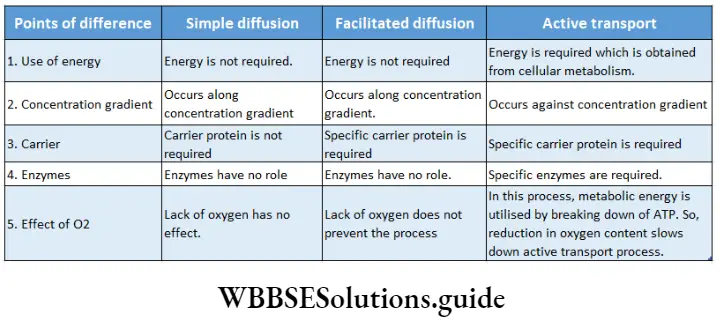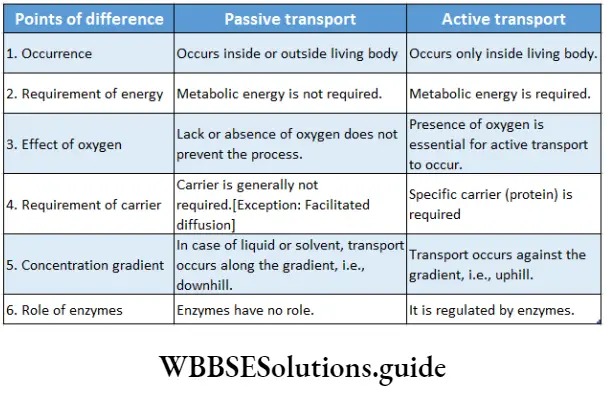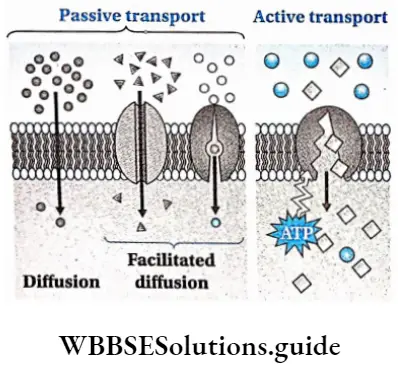Facilitated Diffusion
Facilitated Diffusion Definition: The process of passive transport (no energy required) by which molecules or ions of living cells move from a region of higher concentration to a region of lower concentration, through the integral protein present in the cell membrane is called facilitated diffusion.
Facilitated Diffusion Explanation: Diffusion of molecules across the membrane depends on their solubility in lipids. Polar ions are soluble in water but insoluble in lipids. They are large in size and so cannot cross the cell membrane. Moreover, the lipids present in the cell membrane have hydrophobic tails.
“facilitated diffusion definition and examples in biology”
Due to this, polar ions cannot enter the cell by simple diffusion. In order to transport such ions, carrier proteins and channel proteins are present within the cell membrane. These proteins are called transmembrane proteins.
They have specific configurations that help them to transport specific molecules. Glucose, amino acids, and ions (Na+, Cl–) are transported across the cell membrane by this mechanism.
” define facilitated diffusion”
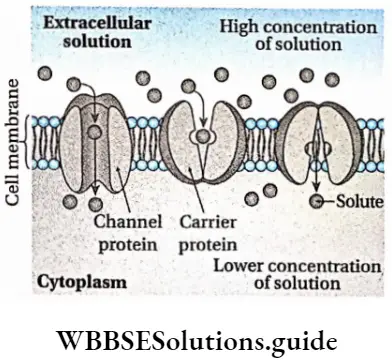
Facilitated Diffusion Characteristic features:
- Facilitated diffusion in living cells is a passive process that does not require any energy.
- Facilitated diffusion occurs along the concentration gradient.
- Certain large proteins called ionosphere or porin, span across the cell membrane. They have specific binding sites for particular molecules. These proteins change their configuration to form huge pores or channels when they bind with specific molecules. This allows the entry of large peptides, small proteins, and molecules of different substances inside the cells.
- Smaller molecules show a higher rate of facilitated diffusion than larger molecules.
- Channel proteins allow the transport of some specific substances across the cell membrane.
- Channel proteins are usually gated i.e., they may be open or closed. When a gate is open, solutes of appropriate size may diffuse.

“facilitated diffusion example “
Types based on the direction of transport: Facilitated diffusion allows the transportation of one or more substances across the membrane. Based on the number of transported substances and the direction of their movement, facilitated diffusion has been classified into the following three types.
“difference between simple diffusion and facilitated diffusion”
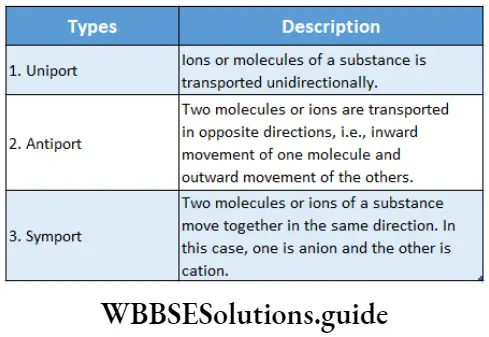
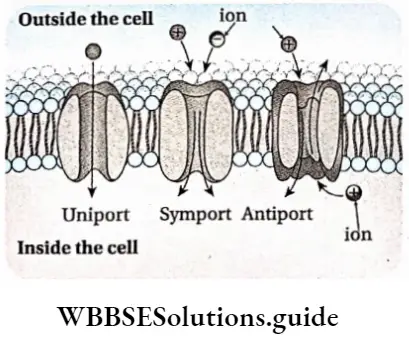
“facilitated transport “
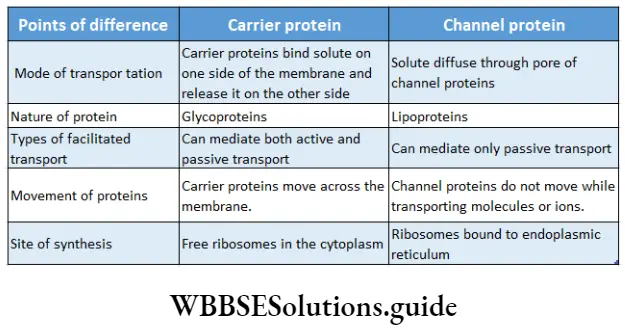
Facilitated Diffusion Significance:
- Carbohydrates, amino acids, phosphate, CO+, Na+, K+, etc., are transported into the cell by this process.
- Polar molecules and ions are also transported across membranes of cell organelles like mitochondria, through this process.
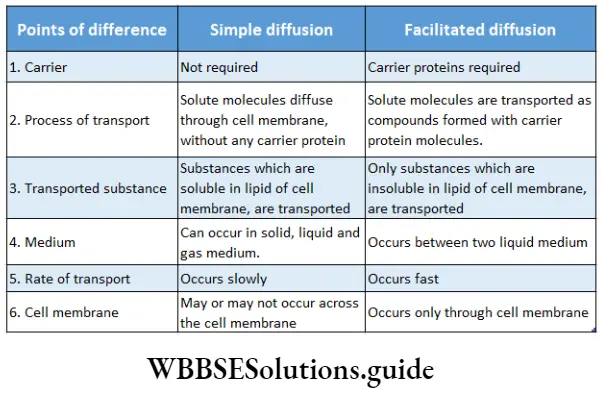
“facilitated diffusion “
Similarities between simple diffusion and facilitated diffusion
- Both are passive transport processes, hence both do not require energy.
- In both cases, ions or molecules move from a region of higher concentration to a region of lower concentration
Active Transport
Active Transport Definition: The process of transport in which ions or molecules of a substance are transported, across the cell membrane with the expenditure of metabolic energy, using carrier protein or enzymes, against the concentration gradient is called active transport.
Active Transport Characteristics features:
- Metabolic energy is utilized in active transport. This energy is obtained by the breakdown of ATP (ATP —> ADP + Pi) during metabolic reactions.
- Active transport is carried out by carrier proteins which are present in the plasma membrane. Carrier proteins are substance-specific.
- Active transport occurs against the concentration gradient, i.e., movement of molecules or ions occurs from lower concentration to higher concentration. So, this type of transport is also called uphill transport.
- In the absence of oxygen, respiration slows down. It lowers ATP production. As the availability of energy decreases, the rate of active transport declines.
- In most cases, active transport is accompanied by passive transport.
- Substances called Inhibitors inhibit the process by reacting with the membrane proteins.
- The rate of transport reaches its maximum level when all protein carriers are already bound with ions or molecules.
| Class 11 Biology | Class 11 Chemistry |
| Class 11 Chemistry | Class 11 Physics |
| Class 11 Biology MCQs | Class 11 Physics MCQs |
| Class 11 Biology | Class 11 Physics Notes |
“role of carrier proteins in facilitated diffusion with examples”
Active Transport Significance:
- Absorption of water by roots j takes place through an active transport mechanism. Although soil water is absorbed by endosmosis, but absorption of minerals occurs by an active transport process, called an ion exchange mechanism.
- During photosynthesis and respiration, ATP molecules are synthesized through a mechanism that is dependent upon the active transport mechanism.
Different theories or models have been proposed by various scientists regarding the active transport of ions or molecules across the plasma membrane.
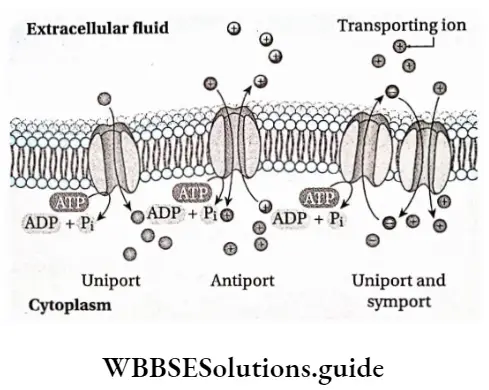
Heinz and Walsh’s model for active transport:
- In 1958, Heinz and Walsh first proposed a model for the active transport of ions or molecules across plasma membranes. The model is described as follows
- Carrier proteins bind with ions or molecules which are to be transported. This complex thus formed is called carrier complex. It is formed by using kinetic or metabolic energy, at the external face of the plasma membrane. The carrier complex moves across the plasma membrane and reaches the internal face.
- On the internal face, carrier protein and ions or molecules separate and ions or molecules enter the cytoplasm.
- Carrier proteins become inactive due to the action of enzymes and return to the external face of the cell membrane,
- The cycle repeats when the carrier proteins regain their activity by the action of metabolic energy.
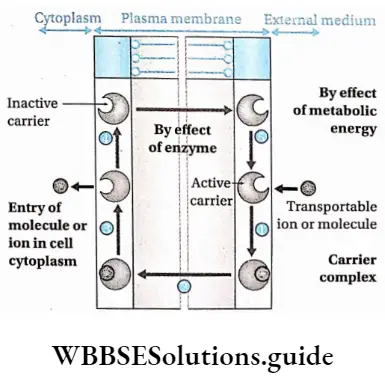
Singer’s model of solute transport: There are two types of proteins in the cell membrane. Proteins present on the outer surface of the membrane are extrinsic or peripheral proteins. Proteins embedded in the lipid are intrinsic or integral proteins. Singer (1974-75) has described the role of extrinsic and intrinsic proteins in the active transport of solutes.
“facilitated diffusion of sodium and potassium ions in neurons”
“difference between carrier and channel proteins in diffusion”
- Integral proteins (1) in the plasma membrane are extended across the membrane and form a protein channel within it. Water molecules pass through this channel but solute molecules cannot.
- Extrinsic or peripheral proteins (P) bind with ions and molecules of substances and fuse with integral proteins (1).
- Conformational change of integral protein occurs due to the breakdown of ATP. This creates a passage through the channel protein and allows the entry of ions or molecules into the cell.
